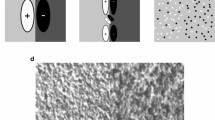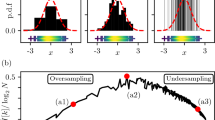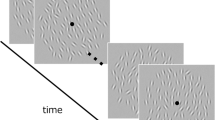Abstract
Recent computational and psychological theories of human texture vision1–3 assert that texture discrimination is based on first-order differences in geometric and luminance attributes of texture elements, called 'textons'4. Significant differences in the density, orientation, size, or contrast of line segments or other small features in an image have been shown to cause immediate perception of texture boundaries. However, the psychological theories, which are based on the perception of synthetic images composed of lines and symbols, neglect two important issues. First, how can textons be computed from grey-level images of natural scenes? And second, how, exactly, can texture boundaries be found? Our analysis of these two issues has led to an algorithm that is fully implemented and which successfully detects boundaries in natural images5. We propose that blobs computed by a centre-surround operator are useful as texture elements, and that a simple non-parametric statistic can be used to compare local distributions of blob attributes to locate texture boundaries. Although designed for natural images, our computation agrees with some psycho-physical findings, in particular, those of Adelson and Bergen (described in the preceding article6), which cast doubt on the hypothesis that line segment crossings or termination points are textons.
This is a preview of subscription content, access via your institution
Access options
Subscribe to this journal
Receive 51 print issues and online access
$199.00 per year
only $3.90 per issue
Buy this article
- Purchase on Springer Link
- Instant access to full article PDF
Prices may be subject to local taxes which are calculated during checkout
Similar content being viewed by others
References
Marr, D. Cold Spring Harb. Symp. quant. Biol. Vol. XL, 647–662 (1976).
Beck, J., Prazdny, K. & Rosenfeld, A. in Human and Machine Vision (eds Beck, J., Hope, B. & Rosenfeld, A.) 1–38 (Academic, New York, 1983).
Julesz, B. & Bergen, J. R. The Bell System Technical Journal 62, 1619–1645 (1983).
Julesz, B. Nature 290, 91–97 ((1981).
Voorhees, H. M.I.T. Artificial Intelligence Lab, Technical Report number 968, 1987.
Bergen, J. P. & Adelson, E. H. Nature 333, 363–364 (1988).
Julesz, B. Biol. Cybern. 54, 245–251 (1986).
Beck, J., Sutter, A. & Ivry, R. Computer Vision Graphics Image Proc. 37(2), 299–325 (1987).
Riley, M. D. M.I.T. Artificial Intelligence Lab, Technical Report 649 (1981).
Author information
Authors and Affiliations
Rights and permissions
About this article
Cite this article
Voorhees, H., Poggio, T. Computing texture boundaries from images. Nature 333, 364–367 (1988). https://doi.org/10.1038/333364a0
Received:
Accepted:
Issue Date:
DOI: https://doi.org/10.1038/333364a0
This article is cited by
-
The First 3D Model of the Full-Length KIT Cytoplasmic Domain Reveals a New Look for an Old Receptor
Scientific Reports (2020)
-
Hierarchy and adaptivity in segmenting visual scenes
Nature (2006)
Comments
By submitting a comment you agree to abide by our Terms and Community Guidelines. If you find something abusive or that does not comply with our terms or guidelines please flag it as inappropriate.



